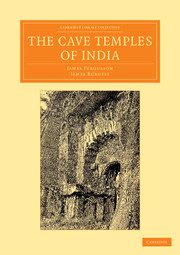
- Publisher:
- Cambridge University Press
- Online publication date:
- May 2014
- Print publication year:
- 2013
- First published in:
- 1880
- Online ISBN:
- 9781139506632
Last updated 10th July 2024: Online ordering is currently unavailable due to technical issues. We apologise for any delays responding to customers while we resolve this. For further updates please visit our website https://www.cambridge.org/news-and-insights/technical-incident


Born in Scotland, James Fergusson (1808–86) spent ten years as an indigo planter in India, the profits from which allowed him to embark upon a second career as an architectural historian. Although he had no formal training, he became one of the most respected researchers in the field, particularly in Indian architecture. He made numerous trips around India in order to study and document its cave temples, publishing his first book on the subject in 1845. In 1880, he returned to the subject, collaborating with the archaeologist James Burgess (1832–1916) as part of the Archaeological Survey of India. It was Fergusson who first categorized the temples, suggesting that they could be classified through reference to the religious order and function. Illustrated with more than 150 maps, plans and drawings, this work of impressive scope remains of relevance to students of Indian architecture and history.
 Loading metrics...
Loading metrics...
* Views captured on Cambridge Core between #date#. This data will be updated every 24 hours.
Usage data cannot currently be displayed.